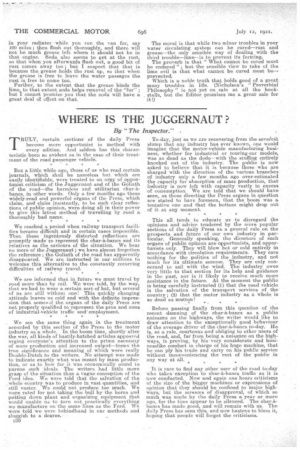WHERE IS THE JUGGERNAUT?
Page 26

If you've noticed an error in this article please click here to report it so we can fix it.
By "The Inspector."
TRTJLY, certain sections of the daily Press become more opportunist in method with
• every edition. And seldom has this characteristic been so evident as in the case of their treatanent of the road passenger vehicle.
But a little while ago, those of us who read certain journals, which shall be nameless but which are easily identifiable, were treated to an orgy of opportunist criticism of the Juggernaut and of the Goliath of the road—the harmless and utilitarian char-abanes, in other words. Only a few months ago these widely-read and powerful organs of the Press, which claim, and claim insistently, to be such clear reflections of public opinion, were doing all in their power to give this latest method of travelling by road a thoroughly bad name.
We reached a period when railway transport facilities became difficult and in certain cases impossible. Then these ingeniously distorted reflections are promptly made' to represent the char-i-bancs and its relatives as the saviours of the situation. We hear no more of the Juggernaut ;-we have almost forgotten the reference ; the Goliath of the road has apparently disappeared. We are instructed in our millions to welcome this alternative to the constantly recurring difficulties of railway travel. .
We are informed that in future we must travel by road more than by rail. We were told, by the way, that we had to wear a certain sort.of hat, but several 'of us are still without one This quickly changing attitude leaves us cold and with the definite impression that somesal the organs of the daily Press are not properly qualified to represent the pros and cons of industrial-vehicle traffic and' emoloynaent.
' * * * * • , We see the same thing again in the treatment accorded by this section of the Press to the motor industry as a whole. In the boom time, shortly after the war, all kinds of hastily-hatched articles appeared urging everyone's attention to the prime necessity of mass production and increased output—terms the true significance and meaning of which were really Double-Dutch to the writers. No attempt was made to indicate exactly what was meant by mass production, or as to how far it. was economically sound to pursue such ideals. The writers had little more grasp of the situation than a vague conception of the Ford idea. We were told that the salvation of the ,whole country was to produce in vast quantities, and ' still vaster. We could not produce too much, We -were rated for not taking the bull by the horns and putting down plant and organizing equipment that would enable us to turn out practically everything we manufacture on the same lines as the Ford. We were told we were behindliand in our methods and sluggish to a degree.. ' a c30
To-day, just as we are recovering from the seveieit slump that any industry has ever known, one would imagine that the motor-vehicle manufacturing business, whether for industrial or touring-car models, was as dead as the dodo—with the stuffing entirely knocked out of the industry. The public i5 now asked to believe that it is because those who are charged with the direction of the various branches 'of industry only a few months ago over-estimated the capacity for absorption of mass production, that • industry is now left with capacity vastly in excess of consumption. We are told that we should have seen, as those directing the Press organs in question are stated -to have foreseen, that the boom was a tentative one and that the bottom might drop out of it at any moment.
This all, tends to educate us to disregard the opinions and advice tendered by the more popular sections of the daily Press as a general rule on the prospects and future of our own industry in particular. Generally speaking, the directors of such organs of public opinion are opportuniste, and opportunists only. They will blow hot or cold entirely in accordance with circulation requirements. They care nothing for the politics of the industry, and not much for its ultimate success. They are only concerned to sail with the wind. The industry owes very little to that section for its help and guidance in the past, nor is it likely to receive much more assistance in the future. At the moment the public is being carefully instructed (1) that the road vehicle is the salvation of the transport services of the country; (2) that the motor industry as a whole is as dead as mutton!
Before passing finally from this question of the recent damning of -the char-a-bancs as a public nuisante on the highways, the writer would like to draw attention to the exceptionally good behaviour of the average driver of the char-a-bancs to-day. He is, as a rule, courteous and obliging to other users of the road, and, far from being a nuisance on the highways, is proving, by his 'veryconsiderate and businesslike conduct in charge of his huge machine, that he can ply his trade and carry on his public service without inconveniencing the rest of the public in
any way at all. a It is rare to find any other user of the road to-day who takes exception to char-a-bancs traffic as it is now conducted. Now and again one hears criticisms of the size of the bigger machines or expressions of opinion that they should be confined to major highways, but the screams of disapproval, of which so much was made by the daily Press a year or more ago, for the time appear to be silenced. The char-A-banes has made good, and will remain with us. The daily Press has seen this, and now hastens to bless it, hoping that people will forget the criticisms.
































